This site uses only a few technical cookies necessary for its operation. By continuing to browse, you accept their use.
To find out more...
To find out more...
Let's rehabilitate spinach
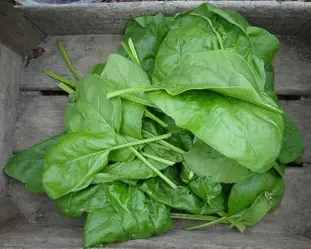
We are currently (as I write this) in the season of fresh spinach, and it is a delicious vegetable that unfortunately has a bad reputation among a lot of people, children and teenagers in particular.
I wonder if this lack of appetite isn't due to what I call, probably unfairly, "school food spinach"? That is to say a rather tasteless green purée, of a very unappetizing aspect, and that most children know, alas. And it's a pity, because spinach, well prepared, not chopped, is both delicious and healthy (but with little iron, despite Popeye, a little reference for those who were born before 1980).
But for spinach to stay good, you have to buy it in season, right now, close to home if possible, and prepare and cook it with care, that is to say very briefly.
You don't know how to do it? No problem, I'll show you.
I wonder if this lack of appetite isn't due to what I call, probably unfairly, "school food spinach"? That is to say a rather tasteless green purée, of a very unappetizing aspect, and that most children know, alas. And it's a pity, because spinach, well prepared, not chopped, is both delicious and healthy (but with little iron, despite Popeye, a little reference for those who were born before 1980).
But for spinach to stay good, you have to buy it in season, right now, close to home if possible, and prepare and cook it with care, that is to say very briefly.
You don't know how to do it? No problem, I'll show you.
8,118 4.8/5 (15 reviews)
Keywords for this post:SpinachCookingRecipeMethodBlanchingLast modified on: May 7th 2021
Let's rehabilitate spinach
The preparation
This is not very complicated, we treat them a bit like salad: plunged in cold water with vinegar to wash them, you drain, and it's finished.It's a matter of taste, but if, like me, you don't like the hard part of the spinach leaf, the vein, you can remove it by pulling on it and put it in the compost, it separates from the leaf quite easily.
Well no mystery, it's a lot of work, you have to do it leaf by leaf, but the result is worth your efforts.
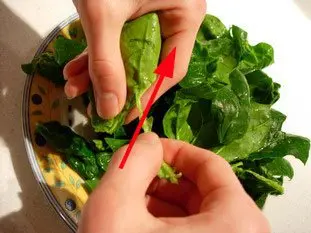
Note that from now on (put them through the salad spinner first) you can already eat the spinach raw, in a salad for example, alone or with other things, it is already very good. It can also replace salad, for example in the burgers we talked about not long ago.
Cooking ways
There are 2 main ways to cook them:1) Fallen ("Tombés" in French)
This is a rather simple method, rather fast: You put a large frying pan on high heat, with a big knob of butter or a little olive oil, and when all this is quite hot you put a good big packet of prepared spinach leaves in the pan.
Be careful it crackles a lot because of the water left on the leaves, you stir the leaves a bit and they will "fall", that is to say cook, in 2 or 3 minutes maximum.
Put aside, and repeat the operation until all your spinach falls.
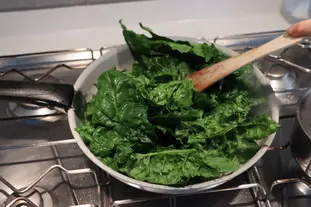
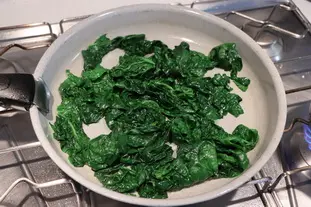
2) Blanching
A little longer method: You boil a big pot of salted water, and you plunge in a big packet of prepared spinach leaves, stir a little and as soon as the boiling starts again, it's cooked (2 minutes max).
Remove from the water with a skimmer or spider and plunge into cold water to stop the cooking.
Drain once cooled, then pass to the salad spinner to dry. You can also consult these detailed explanations.
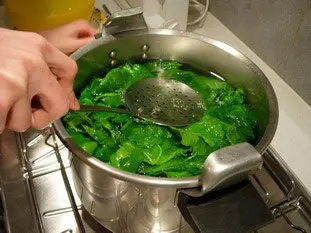
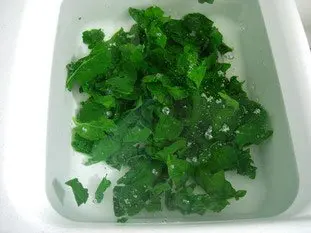
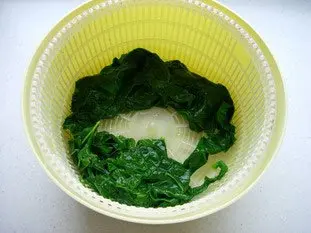
Whatever the cooking method you have chosen, the spinach prepared in this way is ready to be used in the recipe of your choice. It retains its beautiful emerald-coloured leafy appearance, especially when blanched, and its delicate taste.
As for the recipes, it is also a matter of taste, but spinach can be used in many recipes, whether raw or cooked!
I can't resist the pleasure of recommending an association that works incredibly well, it's fresh spinach with cream: For example a simple omelette in which you put cooked spinach, or spinach with cream and served with slices of hard-boiled eggs, a delight!
Tosum up: Eating spinach in season, prepared and cooked with care, is the guarantee of delicious seasonal recipes.
Lasts posts
Butter vs. grease
We often read in a recipe where a pastry is put into a mould that, just before pouring, the mould should be buttered or greased. But what's the difference between these 2 terms?December 1st 20259965
Getting out of the fridge early
Very often when you're cooking, you need to take food or preparations out of the fridge, to use them in the recipe in progress. There's nothing tricky about this: you just take them out of the fridge and use them, usually immediately, in the recipe. But is this really a good method?November 24th 20251,1265
Who's making the croissants?
When you look at a bakery from the outside, you naturally think that in the bakery, the bakers make the bread, and in the laboratory, the pastry chefs make the cakes. It's very often like that, with each of these professions having quite different ways of working, but sometimes there's also one...November 23th 20251,018
Oven height
When we put a dish or cake in the oven, we naturally tend to put it on the middle shelf, and that's what we usually do. But in some cases, this position and height can be a little tricky, so let's find out why.October 8th 20252,7645
The importance of sieving
In recipes that use a fine powder (flour, powdered sugar, etc.), you'll often see the advice to sift before using it. To sift is to pass the powder in question through a sieve (a very fine strainer) before incorporating it into your recipe. It's often advice, but is it really useful?September 3rd 20257,5353
Other pages you may also like
Fruits which can ruin your jelly
There are many ways of making a fruit mousse, but one of the simplest is to prepare a fruit jelly (basically a fresh fruit coulis with gelatine) and then mix this jelly before it sets completely with whipped cream. The result is perfect for filling a charlotte, for example. But do beware;...March 6th 201378 K4.0
Different kinds of pastry and dough
When cooking in general, and particularly in baking, we can make and use many different kinds of pastry and dough. All built on the same "base": flour - a powder to which we add fat, liquid or both to produce the dough which is then cooked. .November 6th 2012111 K 14.0
Preserving egg yolks
If you're using only the egg whites in a recipe (such as meringues ), you'll need to store the yolks until you're ready to use them again. There's nothing very complicated about this in principle - all you have to do is chill them, but there are a few pitfalls to be avoided in practice.June 18th 20248,1355
The 3 kinds of meringue
Meringue – what could be simpler? Just beaten egg whites with sugar added. This makes a fairly stiff mixture which can then be cooked in a cool oven to create those lovely, light confections. But in the world of professional patisserie, meringue comes in three different kinds. Even if the...June 14th 201364 K4.5
Raising (or leavening) agents
When we want to make a dough or batter rise when baking, either in patisserie or bread-making, we need to use a raising agent or leavening agent, one of which is called leaven. In the context of baking, a raising agent is simply what "makes something rise". It is a substance which, when added to...June 16th 202157 K4.8
Post a comment or question
Follow this page
If you are interested in this page, you can "follow" it, by entering your email address here. You will then receive a notification immediately each time the page is modified or a new comment is added. Please note that you will need to confirm this following.
Note: We'll never share your e-mail address with anyone else.
Alternatively: you can subscribe to the mailing list of cooling-ez.com , you will receive a e-mail for each new recipe published on the site.









